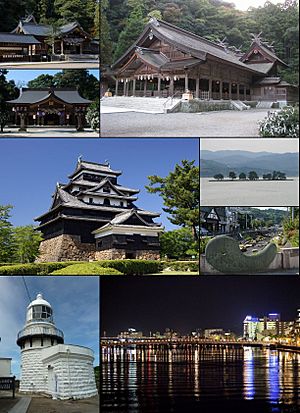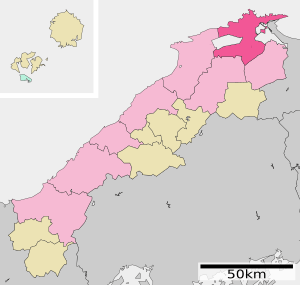Matsue facts for kids
Quick facts for kids
Matsue
松江市
|
|||||||||||
|---|---|---|---|---|---|---|---|---|---|---|---|

From top left: Kumano Taisha, Yaegaki Shrine, Miho Shrine, Matsue Castle, Lake Shinji (Yomegashima), Tamatsukuri hot springs, Mihonoseki Lighthouse, Night view of Matsue
|
|||||||||||
|
|||||||||||
 |
|||||||||||
| Country | Japan | ||||||||||
| Region | Chūgoku (San'in) | ||||||||||
| Prefecture | Shimane | ||||||||||
| Area | |||||||||||
| • Total | 572.99 km2 (221.23 sq mi) | ||||||||||
| Population
(March 31, 2023)
|
|||||||||||
| • Total | 196,748 | ||||||||||
| • Density | 343.371/km2 (889.326/sq mi) | ||||||||||
| Time zone | UTC+09:00 (JST) | ||||||||||
| City hall address | 86 Suetsugu, Matsue-shi, Shimane-ken 690-8540 | ||||||||||
| Climate | Cfa | ||||||||||
|
|||||||||||
Matsue (Japanese: 松江市, Hepburn: Matsue-shi) is a cool city in Japan. It is the capital of Shimane Prefecture. Matsue is located in the Chūgoku region on the island of Honshu.
As of March 31, 2023, about 196,748 people live in Matsue. The city covers an area of about 573 square kilometers (221 square miles). Matsue is famous for its old Matsue Castle. This castle was built during the Tokugawa shogunate period. It is one of the few original feudal castles still standing in Japan today.
Contents
Geography
Matsue is in the northern part of Shimane Prefecture. It sits between two large lakes, Lake Shinji and Nakaumi. The Ohashi River connects these two lakes and runs through the city. Matsue also reaches the Sea of Japan coast.
Matsue is the main city of a larger area around Lake Shinji and Nakaumi. This area has about 600,000 people. It is the fourth largest city area on the Sea of Japan coast.
Climate in Matsue
Matsue has a humid subtropical climate. This means it has very warm summers and cool winters. It rains a lot throughout the year, especially in June, July, and September.
The average temperature in Matsue is about 15.2 degrees Celsius (59.4°F). The city gets about 1792 millimeters (70.6 inches) of rain each year. July is usually the wettest month. August is the hottest month, with an average temperature of 27.1 degrees Celsius (80.8°F). January is the coldest, averaging 4.6 degrees Celsius (40.3°F).
The hottest temperature ever recorded in Matsue was 38.5 degrees Celsius (101.3°F) on August 1, 1994. The coldest was -8.7 degrees Celsius (16.3°F) on February 19, 1977.
| Climate data for Matsue (1991−2020 normals, extremes 1940−present) | |||||||||||||
|---|---|---|---|---|---|---|---|---|---|---|---|---|---|
| Month | Jan | Feb | Mar | Apr | May | Jun | Jul | Aug | Sep | Oct | Nov | Dec | Year |
| Record high °C (°F) | 20.6 (69.1) |
24.7 (76.5) |
26.4 (79.5) |
30.7 (87.3) |
32.4 (90.3) |
35.0 (95.0) |
37.1 (98.8) |
38.5 (101.3) |
36.1 (97.0) |
32.1 (89.8) |
27.4 (81.3) |
23.2 (73.8) |
38.5 (101.3) |
| Mean daily maximum °C (°F) | 8.3 (46.9) |
9.4 (48.9) |
13.1 (55.6) |
18.5 (65.3) |
23.2 (73.8) |
26.2 (79.2) |
29.8 (85.6) |
31.6 (88.9) |
27.1 (80.8) |
22.0 (71.6) |
16.5 (61.7) |
10.9 (51.6) |
19.7 (67.5) |
| Daily mean °C (°F) | 4.6 (40.3) |
5.0 (41.0) |
8.0 (46.4) |
13.1 (55.6) |
18.0 (64.4) |
21.7 (71.1) |
25.8 (78.4) |
27.1 (80.8) |
22.9 (73.2) |
17.4 (63.3) |
12.0 (53.6) |
7.0 (44.6) |
15.2 (59.4) |
| Mean daily minimum °C (°F) | 1.5 (34.7) |
1.3 (34.3) |
3.6 (38.5) |
8.2 (46.8) |
13.5 (56.3) |
18.2 (64.8) |
22.8 (73.0) |
23.8 (74.8) |
19.6 (67.3) |
13.4 (56.1) |
8.0 (46.4) |
3.6 (38.5) |
11.4 (52.5) |
| Record low °C (°F) | −6.9 (19.6) |
−8.7 (16.3) |
−4.7 (23.5) |
−2.1 (28.2) |
2.4 (36.3) |
7.8 (46.0) |
12.9 (55.2) |
15.3 (59.5) |
7.9 (46.2) |
1.6 (34.9) |
−2.4 (27.7) |
−7.5 (18.5) |
−8.7 (16.3) |
| Average precipitation mm (inches) | 153.3 (6.04) |
118.4 (4.66) |
134.0 (5.28) |
113.0 (4.45) |
130.3 (5.13) |
173.0 (6.81) |
234.1 (9.22) |
129.6 (5.10) |
204.1 (8.04) |
126.1 (4.96) |
121.6 (4.79) |
154.5 (6.08) |
1,791.9 (70.55) |
| Average snowfall cm (inches) | 28 (11) |
25 (9.8) |
6 (2.4) |
0 (0) |
0 (0) |
0 (0) |
0 (0) |
0 (0) |
0 (0) |
0 (0) |
0 (0) |
11 (4.3) |
68 (27) |
| Average precipitation days (≥ 0.5 mm) | 21.1 | 16.9 | 15.0 | 11.6 | 10.4 | 12.0 | 12.7 | 10.6 | 12.6 | 12.0 | 14.9 | 19.8 | 169.7 |
| Average relative humidity (%) | 76 | 74 | 72 | 70 | 71 | 78 | 80 | 77 | 79 | 76 | 76 | 76 | 75 |
| Mean monthly sunshine hours | 67.4 | 88.6 | 140.5 | 182.4 | 206.5 | 157.1 | 168.6 | 201.0 | 146.2 | 154.4 | 113.8 | 78.8 | 1,705.2 |
| Source: Japan Meteorological Agency | |||||||||||||
| Climate data for Kashima, Matsue (1991−2020 normals, extremes 1978−present) | |||||||||||||
|---|---|---|---|---|---|---|---|---|---|---|---|---|---|
| Month | Jan | Feb | Mar | Apr | May | Jun | Jul | Aug | Sep | Oct | Nov | Dec | Year |
| Record high °C (°F) | 19.3 (66.7) |
22.7 (72.9) |
24.7 (76.5) |
29.3 (84.7) |
31.8 (89.2) |
35.1 (95.2) |
36.8 (98.2) |
37.5 (99.5) |
35.8 (96.4) |
31.7 (89.1) |
26.8 (80.2) |
22.2 (72.0) |
37.5 (99.5) |
| Mean daily maximum °C (°F) | 8.3 (46.9) |
9.1 (48.4) |
12.5 (54.5) |
17.8 (64.0) |
22.5 (72.5) |
25.6 (78.1) |
29.1 (84.4) |
30.7 (87.3) |
26.7 (80.1) |
21.8 (71.2) |
16.5 (61.7) |
11.1 (52.0) |
19.3 (66.8) |
| Daily mean °C (°F) | 4.8 (40.6) |
5.0 (41.0) |
7.7 (45.9) |
12.5 (54.5) |
17.4 (63.3) |
21.1 (70.0) |
25.1 (77.2) |
26.3 (79.3) |
22.3 (72.1) |
16.9 (62.4) |
11.8 (53.2) |
7.1 (44.8) |
14.8 (58.7) |
| Mean daily minimum °C (°F) | 1.3 (34.3) |
0.9 (33.6) |
2.6 (36.7) |
6.9 (44.4) |
12.3 (54.1) |
17.3 (63.1) |
21.8 (71.2) |
22.6 (72.7) |
18.4 (65.1) |
12.3 (54.1) |
7.4 (45.3) |
3.4 (38.1) |
10.6 (51.1) |
| Record low °C (°F) | −6.6 (20.1) |
−9.9 (14.2) |
−4.5 (23.9) |
−2.3 (27.9) |
2.5 (36.5) |
9.1 (48.4) |
12.3 (54.1) |
14.7 (58.5) |
7.3 (45.1) |
3.0 (37.4) |
−0.8 (30.6) |
−3.5 (25.7) |
−9.9 (14.2) |
| Average precipitation mm (inches) | 143.7 (5.66) |
108.0 (4.25) |
124.9 (4.92) |
105.6 (4.16) |
121.5 (4.78) |
166.9 (6.57) |
224.8 (8.85) |
136.4 (5.37) |
198.9 (7.83) |
122.6 (4.83) |
131.8 (5.19) |
157.7 (6.21) |
1,742.8 (68.61) |
| Average precipitation days (≥ 1.0 mm) | 18.4 | 14.4 | 13.2 | 9.8 | 9.1 | 10.7 | 11.8 | 9.5 | 11.5 | 10.6 | 13.4 | 17.9 | 150.3 |
| Mean monthly sunshine hours | 55.8 | 81.0 | 142.1 | 192.4 | 215.8 | 163.8 | 181.6 | 214.9 | 156.9 | 157.8 | 105.8 | 67.1 | 1,735.1 |
| Source: Japan Meteorological Agency | |||||||||||||
How Many People Live in Matsue?
Based on Japanese census data, Matsue had 203,616 people in 2020. The city has been counting its population since 1920.
| Historical population | ||||||||||||||||||||||||||||||||||||||||||||||||||||||||||||||||||||||||||
|---|---|---|---|---|---|---|---|---|---|---|---|---|---|---|---|---|---|---|---|---|---|---|---|---|---|---|---|---|---|---|---|---|---|---|---|---|---|---|---|---|---|---|---|---|---|---|---|---|---|---|---|---|---|---|---|---|---|---|---|---|---|---|---|---|---|---|---|---|---|---|---|---|---|---|
|
|
|
||||||||||||||||||||||||||||||||||||||||||||||||||||||||||||||||||||||||
| Matsue population statistics | ||||||||||||||||||||||||||||||||||||||||||||||||||||||||||||||||||||||||||
History of Matsue
Matsue is in an old area called Izumo Province. Many old sites from different time periods have been found here. These include sites from the Yayoi, Kofun, and Nara periods.
The city of Matsue as we know it today started when Horio Yoshiharu built Matsue Castle. He also planned the town around it between 1607 and 1611. Matsue was an important center for the Matsue Domain under the Tokugawa shogunate. This lasted until the Meiji Restoration, a big change in Japan's history.
After Horio Yoshiharu, the area was ruled by his grandson Tadaharu. When Tadaharu died without children, the Kyōgoku clan took over. Later, in 1637, the Matsudaira clan became the rulers. Matsudaira Naomasa, a grandson of the first Tokugawa Shōgun, became the new leader. His family ruled Matsue for ten generations!
The most famous Matsudaira ruler was Matsudaira Harusato, also known as Fumai. He helped the Matsue clan when they had money problems. He encouraged growing mulberry bushes and promoted local foods like shijimi clams. Harusato loved the Japanese tea ceremony. Because of him, Matsue is famous for its wagashi (Japanese sweets), especially one called wakakusa.
When Matsue Grew
- April 1, 1889: The city of Matsue was officially created.
- March 31, 2005: Matsue became much larger. It joined with several nearby towns and a village from Yatsuka District. These included Kashima, Mihonoseki, Shimane, Shinji, Tamayu, Yatsuka, and Yakumo.
- August 1, 2011: The town of Higashiizumo also joined Matsue.
- April 1, 2018: Matsue became a "Core city." This means it gained more control over its own local government.
Economy
Matsue is a big business center in its region. It's one of the main cities in the San'in region. Many company headquarters for businesses in this area are located here.
Farming, commercial fishing, and tourism are very important to Matsue's economy. The city does not have a lot of big factories or industries.
Education
Matsue has several schools and colleges:
Universities and Colleges
- Matsue College of Technology
- Shimane University
- University of Shimane Junior College
Schools for Kids
The city government runs 33 public elementary schools and 17 public junior high schools. There is also one public high school run by the city. The Shimane Prefecture runs seven more public high schools and five special education schools for students with disabilities. Matsue also has four private high schools.
Transportation
Getting around Matsue and to other places is easy with trains and highways.
Trains in Matsue
![]() JR West (JR West) - San'in Main Line
JR West (JR West) - San'in Main Line
- Shinji - Kimachi - Tamatsukuri-Onsen - Nogi - Matsue - Higashi-Matsue - Iya
![]() JR West (JR West) - Kisuki Line
JR West (JR West) - Kisuki Line
- Shinji - Minami Shinji
![]() Ichibata Electric Railway (Bataden) - Kita-Matsue Line
Ichibata Electric Railway (Bataden) - Kita-Matsue Line
- Tsunomori - Takanomiya - Matsue Vogel Park - Aikamachi - Nagae - Asahigaoka - Matsue English Garden Mae - Matsue-Shinjiko-Onsen
Highways in Matsue
 Hamada Expressway
Hamada Expressway Matsue Expressway
Matsue Expressway National Route 9
National Route 9 National Route 54
National Route 54 National Route 431
National Route 431 National Route 432
National Route 432 National Route 485
National Route 485
International Friends
Matsue has "sister city" relationships with other cities around the world and in Japan. These relationships help promote cultural exchange and friendship.
International Friendship Cities
 New Orleans, Louisiana, United States (since 1994)
New Orleans, Louisiana, United States (since 1994) Jilin City, Jilin, China (since 1999)
Jilin City, Jilin, China (since 1999) Jinju, South Gyeongsang, South Korea (since 1999)
Jinju, South Gyeongsang, South Korea (since 1999) Hangzhou, Zhejiang, China (since 2003)
Hangzhou, Zhejiang, China (since 2003) Yinchuan, Ningxia, China (since 2004)
Yinchuan, Ningxia, China (since 2004)
Matsue also has ongoing exchanges with Dublin, Ireland, since 1988.
Sister Cities in Japan
Fun Places to Visit in Matsue
Matsue has many interesting places to explore!
- Gesshō-ji: This is a Buddhist temple famous for its beautiful hydrangeas (flowers) and a huge stone turtle statue.
- Izumo Kokubun-ji ruins: These are the remains of an ancient temple. It's a special historical site in Japan.
- Kamosu Jinja
- Kumano Taisha: A very important shrine in the Izumo area.
- Lafcadio Hearn Memorial Museum: This museum is about an author named Lafcadio Hearn. He taught in Matsue for a year in the 1890s. You can find many monuments and places in the city that honor him.
- Matsue Castle: This is one of only 12 original castles left in Japan! It's the second largest, third tallest, and sixth oldest castle. Around the castle, there's a path through forests with bamboo and old trees. The castle grounds are surrounded by an old moat called "horikawa."
- Miho Jinja
- Sada Jinja: This shrine is home to a special dance called Sada Shin Noh. It's a sacred dance with purification rituals. Dancers hold rush mats and offer them to gods. The dance is passed down through generations. In 2011, Sada Shin Noh was added to UNESCO's list of important cultural heritage.
- Shimane Art Museum
- Tamatsukuri Onsen: A famous hot spring area where you can relax.
- Tanabe Art Museum
- Yaegaki Jinja
Exciting Festivals
Matsue has many traditional festivals that are still celebrated today.
- Dōgyōretsu: This is a drum parade held every year on the third Sunday of October.
- Hōranenya: This is one of Japan's top three boat festivals! It only happens once every 10 years. The last one was in May 2019.
Famous People from Matsue
- Hiroyuki Hosoda: A well-known politician.
- Takashi Nagai: A doctor and Catholic writer.
- Kei Nishikori: Born in Matsue in 1989, he is a famous tennis player.
- Wakatsuki Reijirō: A former Prime Minister of Japan.
- Shirō Sano: An actor.
See also
 In Spanish: Matsue (Shimane) para niños
In Spanish: Matsue (Shimane) para niños




